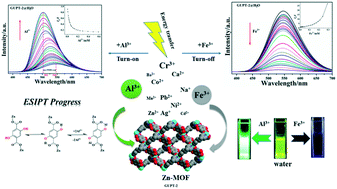A study of GUPT-2, a water-stable zinc-based metal–organic framework as a highly selective and sensitive fluorescent sensor in the detection of Al3+ and Fe3+ ions†
Abstract
A novel luminescent Zn(II)-based metal–organic framework with twofold interpenetrating [Zn(DHT)(BPP)]n (GUPT-2) {GUPT = Guangdong University of Petrochemical Technology, H2DHT = 2,5-dihydroxyterephthalic acid, and BPP = 1,3-di(4-pyridyl)propane} was successfully synthesized using the solvothermal method, and displayed a double-interleaved 2D framework. GUPT-2 not only revealed excellent stability in water and multiple organic solvents but also retained its structural integrity at pH values in the range of 3–11. According to electronic structure calculations, electronic transitions in GUPT-2 were governed by the ligand-to-ligand charge transfer (LLCT) mechanism. GUPT-2 exhibited significant luminescence and selectively detected Fe3+ and Al3+ ions, with limit of detection (LOD) values of 0.446 and 0.269 μM, respectively. The lower LOD values for Fe3+ and Al3+ of GUPT-2 are excellent compared with those of most of reported MOF-based sensors. It is interesting to note that GUPT-2 revealed a prominent luminescence color change from faint yellow to bright green under UV irradiation at 360 nm, with an enhancement in the detection of Al3+ ions. More importantly, the fluorescence enhancement (turn on) and blue shift effects on Al3+ were obvious even in the presence of other interfering ions. These excellent fluorescence properties make GUPT-2 a rare selective luminescent probe in the detection of Fe3+ and Al3+ ions in pure water systems.

- This article is part of the themed collection: Coordination Networks


 Please wait while we load your content...
Please wait while we load your content...